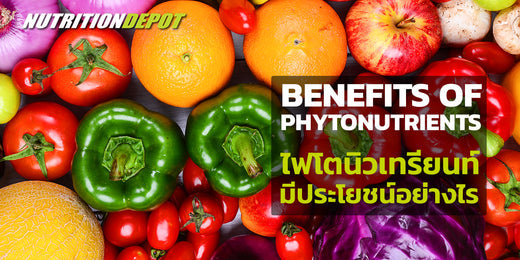Phytonutrients : The benefits of colorful fruits and vegetables
Phytochemicals or Phytonutrients refer to biologically active chemicals found only in plants. These substances may give the vegetable a characteristic color, smell or taste. Many of these phytochemicals are effective against or prevent certain diseases And the important disease that is often said to help is “cancer”.
Mechanism of action of phytochemicals when entering the body, it may help some groups of enzymes work better. Certain enzymes destroy carcinogens, has the effect of inactivating carcinogens, more than 15,000 different phytochemicals have been identified to date.
Yellow is rich in lutein and zeaxanthin, such as ginger, lemon, pineapple, banana.
- Antioxidant
- Stimulate the activity of various enzymes
- Enhance the function of the stomach
- Reduce blood sugar levels
- Enhance the microorganisms in the digestive tract to be healthy.
Orange is rich in beta-carotene such as carrots, oranges.
- Antioxidant
- Enhance hormonal function
- Strengthen the process of ovulation and fertility.
Red is rich in lycopene such as red bell pepper, tomatoes, strawberries.
- Anti-inflammatory
- Antioxidant
- Strengthen the immune system
Green is rich in folate, such as green leafy vegetables.
- Antioxidant
- Strengthen the heart and blood vessels
- Strengthen biochemical processes in the body.
Purple-blue is rich in flavonoids such as black grapes, blueberries
- Antioxidant
- Enhance memory
- Balance the mood
- Nourish nerve cells in the brain and nervous system
Some fruits and vegetables have a relatively high concentration of phytonutrients such as carrots, grapefruits, mangos, papayas, purple cabbage, tomatoes, watermelons.
Phytonutrients ประโยชน์ของผักผลไม้หลากสี
สารพฤกษเคมี หรือ ไฟโตนิวเทรียนท์ หมายถึง สารเคมีที่มีฤทธิ์ทางชีวภาพที่พบเฉพาะในพืช สารกลุ่มนี้อาจเป็นสารที่ทำให้พืชผักชนิดนั้นๆ มีสี กลิ่น หรือรสชาติ ที่เป็นลักษณะเฉพาะตัว สารพฤกษเคมีเหล่านี้หลายชนิดมีฤทธิ์ต่อต้าน หรือป้องกันโรคบางชนิด และโรคสำคัญที่มักจะกล่าวกันว่าสารกลุ่มนี้ช่วยป้องกันได้คือ “โรคมะเร็ง”
กลไกการทำงานของสารพฤกษเคมีเมื่อเข้าสู่ร่างกาย อาจเป็นการช่วยให้เอ็นไซม์บางกลุ่มทำงานได้ดีขึ้น เอ็นไซม์บางชนิดทำหน้าที่ทำลายสารก่อมะเร็งที่เข้าสู่ร่างกาย มีผลทำให้สารก่อมะเร็งหมดฤทธิ์ ซึ่งปัจจุบันพบสารพฤกษเคมีแล้วมากกว่า 15,000 ชนิด ตัวอย่างไฟโตนิวเทรียนท์ที่รู้จักกันดี เช่น
สีเหลือง อุดมไปด้วยลูทีนและซีแซนทีน เช่น ขิง, มะนาว, สับปะรด, กล้วย
- มีฤทธิ์ต้านอนุมูลอิสระ
- กระตุ้นการทำงานของเอนไซม์ต่างๆ
- เสริมการทำงานของกระเพาะอาหาร
- ลดระดับน้ำตาลในเลือด
- มีบทบาทในการส่งเสริมจุลินทรีย์ในระบบทางเดินอาหารให้มีสุขภาพดี
สีส้ม อุดมไปด้วยสารเบต้าแคโรทีน เช่น แครอท, ส้ม
- มีฤทธิ์ต้านอนุมูลอิสระ
- เสริมสร้างการทำงานของฮอร์โมน
- เสริมสร้างกระบวนการตกไข่และการเจริญพันธุ์
สีแดง อุดมไปด้วยสารไลโคปีน เช่น พริกหยวกแดง, มะเขือเทศ, สตรอเบอร์รี่
- ต้านการอักเสบ
- มีฤทธิ์ต้านอนุมูลอิสระ
- เสริมสร้างระบบภูมิคุ้มกัน
สีเขียว อุดมไปด้วยโฟเลท เช่น ผักใบเขียว
- มีฤทธิ์ต้านอนุมูลอิสระ
- เสริมสร้างความแข็งแรงของหัวใจและหลอดเลือด
- เสริมสร้างกระบวนการทางชีวเคมีในร่างกาย
สีม่วง-น้ำเงิน อุดมด้วยฟลาโวนอยด์ เช่น องุ่นดำ, บลูเบอร์รี่
- มีฤทธิ์ต้านอนุมูลอิสระ
- เสริมสร้างความจำ
- ปรับสมดุลอารมณ์
- บำรุงเซลล์ประสาทในสมองและระบบประสาท
ผักผลไม้บางชนิด มีความเข้มข้นของไฟโตนิวเทรียนท์ค่อนข้างสูง เช่น แครอท, ส้มเกรปฟรุต, มะม่วง, มะละกอ, กะหล่ำม่วง, มะเขือเทศ, แตงโม

